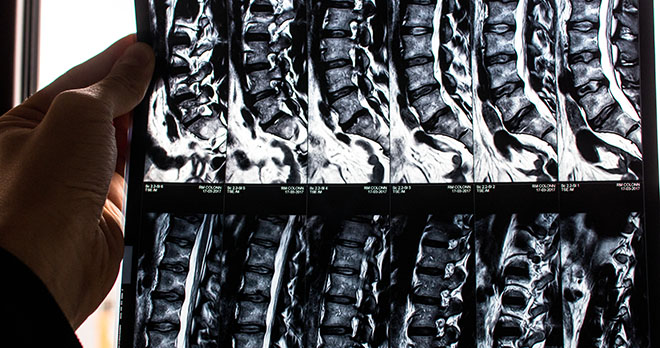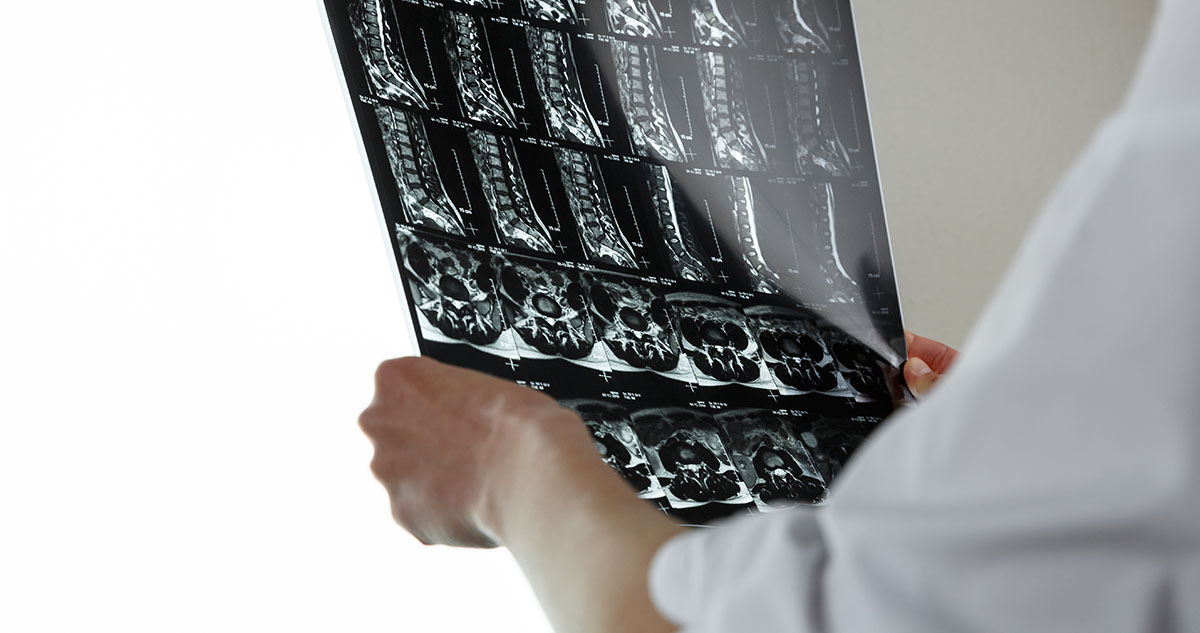

Cauda equina syndrome compensation claims
Cauda equina syndrome is devastating, especially if caused by a delay in diagnosis or a surgical error. If you have developed cauda equina syndrome as a result of a delay or through substandard care, you may have a claim for medical negligence.
Call for a free consultation on whether you have a claim
- No Win No Fee funding available
- We can help find the right support for you
- Offices serving all of England & Wales
- Track record of successful claims
Experts in claiming compensation for cauda equina syndrome
Our cauda equina solicitors have years of experience dealing with spinal injury claims of this nature, and so understand the issues that you are facing following a diagnosis of cauda equina syndrome.
We will build a team of specialists around you, to ensure you can take control of your life through compensation, adaptation and rehabilitation following medical negligence. Our team also sees a claim as an opportunity to throw a spotlight on vital patient safety lessons for medical institutions, avoiding further instances of substandard care.
You are eligible to make a clinical negligence claim for a cauda equina injury, if:
- you have either developed cauda equina syndrome as a result of substandard surgical treatment; or
- you have developed the symptoms of cauda equina syndrome and there has been a negligent delay in treating it, leading to a worse outcome.
Often a claim arises when a patient develops cauda equina symptoms, but their GP or a hospital doctor is not sufficiently alert to them. As a consequence, there is a failure to perform the tests which would allow the condition to be diagnosed, so there is a delay in operating to decompress the affected nerves.
The result will often be that symptoms which might otherwise have been only transitory become permanent. You then have the right to be compensated if your claim can be proved.
It is not particularly easy to know whether you have a viable claim or not; medical negligence is a complicated field, and cauda equina cases can be especially complex.
You will also have only three years from the date of injury, or date of knowledge of the injury, in which to bring a medical negligence claim. We therefore advise that you seek advice from a legal specialist as soon as possible.
If you would like to speak to our team, please contact us on
Recent cases
Simon Elliman and Sarah White secured a lump sum of £400,000 for a 56 year old man (at the date of settlement) for the damage he sustained in June 2017 as a result of a delay in diagnosing and treating Cauda Equina Syndrome. There was an alleged failure by the Defendant GP to provide the Claimant with red flag safety net advice and advise that he should seek urgent treatment if he suffered any of the red flag symptoms of Cauda Equina Syndrome. As a result of this the Claimant suffered severe physical and psychiatric symptoms. The Claimant has been left with significant disabling symptoms including double incontinence and lack of sexual function. His condition is permanent.
On or about 19th June 2017 the Claimant was suffering from shoulder and neck pain, having played tennis the day before, as well as exacerbation of his pre-existing episodic sciatica. The Claimant continued to suffer from neck and shoulder pain as well as sciatic pain and on 21st June 2017 he made an appointment with the Surgery to see a GP the following day. On 22nd June 2017 the Claimant attended the Surgery for his appointment. He was seen by the Defendant who diagnosed tendonitis and gave advice regarding analgesia and exercise. It is the Claimant’s case that no red flag advice was given. At about 20:00 on 22nd June 2017 the Claimant noticed some numbness when passing urine. He considered this to be the effects of the Naproxen he had been prescribed. On 23rd June 2017 the Claimant noticed issues in relation to delay in initiating urination and some reduced flow. The Claimant also noticed altered sensation in his buttocks. At approximately 03:00 on 24th June 2017 the Claimant got up to urinate and noticed loss of sensation around the anus before going back to bed. At around 07:00 on 24th June 2017 the Claimant noticed sensory loss in his buttocks and penis. The Claimant’s wife checked the symptoms on the internet and discovered that they were “red flag” symptoms for cauda equina syndrome. The Claimant called 111. As a result of advice given in the 111 call the Claimant attended the Emergency Department at Hospital where he was clerked at 09:14 and triaged at 09:14 on 24th June 2017. Whilst waiting to see a doctor, at sometime between 11:30 and 12:00 on 24th June 2017, the Claimant suffered from two episodes of urinary incontinence. The Claimant was seen by a doctor at 12:15 on 24th June 2017 and an MRI was arranged with the doctor noting an impression of cauda equina. The MRI report revealed cauda equina compression at L5/S1 due to large central disc extrusion. At 16:20 on 24th June 2017 the Claimant was transferred to a neurological and spinal unit at a different hospital. At approximately 23:00 on 24th June 2017 the Claimant underwent a discectomy operation. A further MRI revealed that disc fragments remained in the spinal canal and the Claimant underwent a second operation on 25th June 2017. An MRI scan on 27th June 2017 revealed that there was still disc extrusion occupying the vertebral canal and a third operation was undertaken on 27th June 2017.
Despite the surgery the Claimant has been left doubly incontinent which has had a massive impact on him practically and emotionally. He performs intermittent self-catheterisation three to four times a day and suffers urinary incontinence. He is at risk of recurrent urinary tract infections. The Claimant lacks bowel and flatus control. He manually self-evacuates. He has sexual dysfunction and suffered a psychiatric injury that has now largely resolved
The Claimant’s physical condition is permanent. He is unable to return to his pre-injury employment. He requires some assistance now and will require further assistance as he ages.








“I was recommended RWK Goodman by a different solicitors firm after my accident in 2009 resulting in a delayed diagnosis of CES (Cauda Equina Syndrome)
The team at RWK Goodman have been great and really helped with making the whole clinical negligence claim run smoothly, and easy to understand explaining everything along the way.
Frequently Asked Questions about cauda equina claims
-
How do you make a compensation claim for cauda equina?
In order to make a compensation claim for cauda equina syndrome, all you need to do is to get in touch with us. We will advise you as to the strength of your claim, and how it can be funded. Following this, we will then obtain all of your medical records, prepare witness statements, commission expert medical evidence, value your claim, and carry out all negotiations on your behalf.
If necessary, we will arrange for the issuing of court proceedings and prepare your case for trial. Only a tiny proportion of cases actually proceed to trial, but it is vital to instruct a lawyer who is prepared to take the case there if necessary.
It can seem daunting to start a claim for compensation against a doctor or other medical professional, but we genuinely will take care of everything on your behalf.
-
How much compensation might I receive for a cauda equina claim?
Each case is different, but a typical settlement will be in excess of £100,000. Many settlements will be far in excess of this and may approach or exceed £1 million. This will compensate you for your pain, suffering, and “loss of amenity” (the loss of ability to do things which you have previously enjoyed) as well as for any direct financial losses which you have suffered.
The general damages for pain and suffering are set quite high because cauda equina syndrome is such a painful and distressing condition. The level of direct financial losses does vary widely from case to case, as you would imagine.
Find out more about how compensation for medical negligence is calculated here
-
How can I fund a claim for cauda equina syndrome?
There are several types of funding available. If you have some form of legal expenses insurance which covers your claim, we can utilise that insurance to fund and support your claim
If we run your claim on a Conditional Fee Agreement (CFA) basis, commonly known as ‘no win, no fee’, then you are guaranteed to retain at least 75% of your damages, with up to 25% being deducted to meet the cost of insurance and a success fee. This is the most frequently used option for claims of this nature, as should the claim be unsuccessful you will have nothing to pay.
-
How long will a cauda equina claim take?
It varies, but a typical case may settle within three years of lawyers being instructed. If negligence is admitted, we will always obtain early interim payments of compensation so the injured person can start to improve their quality of life at the earliest opportunity.

Trusted partners of leading CES charities
As well as being a trusted legal partner to the Spinal Injuries Association, our specialist team is recognised by the Cauda Equina Champions Charity on their Legal Panel as being expert in providing legal support to people with cauda equina.
Symptoms and causes of cauda equina syndrome
Cauda equina syndrome is usually accompanied by some recognisable symptoms which follow a particular pattern.
Early on, people commonly experience a dull ache across the lower back. Weakness, tingling or numbness in the legs or feet is also a frequent symptom, together with difficulty in walking or standing.
Bowel or bladder symptoms are also very common signs of cauda equina syndrome developing. This may involve urinary retention (inability to urinate), incontinence of urine (being unable to control the urge), or just a lack of sensation whilst urinating. A loss of bowel control may also occur.
A symptom which is very distinctive is “saddle anaesthesia” – a feeling of lost or altered sensation in the part of the body which would be in touch with a saddle while sitting on a horse (groin, buttocks, genitals and inner thighs).
A further common symptom is a sharp or stabbing pain in the legs – usually down the back of the thighs and sometimes into the lower legs and feet.
The onset of cauda equina may be acute or gradual:
- In acute onset, sensory and motor deficits in the lower body may develop within 24 hours.
- In gradual onset, symptoms may come and go over a period of several months, with intermittent loss of control of bladder and bowels, in combination with muscle weakness, numbness and sciatica.
It is certainly not the case that every person with cauda equina syndrome complains of precisely the same symptoms. The condition does not follow the same course in every person. For example, not everybody with cauda equina syndrome has lower back pain.
Probably the real “red flag” symptoms – those which should be alerting any doctor to the likelihood of the syndrome – are those associated with urinating mentioned above (inability to urinate, loss of sensation while urinating, loss of control of the urge to urinate) and “saddle anaesthesia” ( the numbness or change in sensation around the groin, buttocks, genitals and inner thighs). Leg weakness, loss of sexual sensation or function and bowel disturbance (incontinence or loss of sensation) are also very important indicators.
Cauda equina syndrome can be caused by negligence in two main ways, either:
-
A surgical procedure
An operation in close proximity to the spinal cord and/or the cauda equina nerves could have gone wrong and caused the syndrome to arise.
If you have had an operation and have unexpectedly been left with symptoms of cauda equina syndrome you should be asking questions as to whether and how the operation has gone wrong.
-
A delay
A delay by doctors to recognise the symptoms and treat the condition.
Your GP should be recognising the “red flag” symptoms and treating you as a medical emergency. Any failure to act urgently may have been negligent. Similarly, even after admission to hospital there may have been negligent delay in carrying out the appropriate MRI scans of your spine, or in getting you into the operating theatre.
It is crucial when treating cauda equina syndrome to decompress the affected nerves as quickly as possible, and any avoidable delay in doing so will be classified as negligent.
Cauda equina syndrome is most commonly caused by a lumbar herniated disc. Essentially, disc material escapes (either due to chronic degeneration or as a result of an acute incident) and begins to place pressure on the nerves within the cauda equina.
However, there are a number of other ways in which cauda equina syndrome can arise:
- As a complication arising from surgery to the lumbar spine
- Following direct trauma to the cauda equina region, such as in a car accident or fall
- As a result of a tumour placing pressure on the spinal canal
- From an infection of the spinal canal (osteomyelitis)
- From an inflammatory condition such as ankylosing spondylitis
- As a result of spinal stenosis (narrowing of the spinal canal), placing pressure on the nerves within the cauda equina.
There are a number of ways in which cauda equina syndrome may be caused by other spinal conditions.
Sometimes surgery to treat another condition in the lumbar spine may result in surgical complications and damages the nerves in the cauda equina. However, other conditions which might cause cauda equina syndrome, such as:
- A tumour – A spinal tumour may cause pressure on the spinal canal, injuring the nerves in the cauda equina. Such a tumour could be a primary (or, where the tumour began), but is more likely to be a secondary tumour which has metastasized (or spread) from another part of the body
- Spinal Osteomyelitis – Spinal osteomyelitis is an infection of a vertebrae in the spine. It is a rare condition, but can lead to damage to the cauda equina if an abscess forms and places pressure on the spinal canal.
- Inflammatory conditions, such as ankylosing spondylitis.
Cauda equina syndrome is sometimes caused or worsened by negligent medical care. This typically occurs if there is delay in either referring somebody with suspected cauda equine symptoms to hospital, or in making the diagnosis and treating it appropriately when admitted to hospital.
There may often be only a short window of opportunity between the condition being “incomplete” (where prompt intervention may produce a reasonably favourable outcome) and “complete”, after which it is unlikely that any intervention will alter the outcome. Time is therefore “of the essence” in treatment of the condition.
If you believe that there may have been any delay in your treatment – either at the primary care stage or after admission to hospital – it would be worth instructing a specialist solicitor to investigate your claim.
Furthermore, if you have undergone surgery to the lumbar spine for another spinal condition, but have ended up with symptoms consistent with cauda equina syndrome (pain, numbness, paralysis, loss of bowel and/or bladder function, loss of sexual function) again you should seek legal advice. It may be that this outcome was avoidable if the surgery had been conducted competently.
Finally, if cauda equina syndrome has occurred following spinal surgery, and you were not warned prior to undergoing the procedure that this was a risk of the procedure, you may have a claim on the basis that you did not give properly informed consent. To succeed in such a claim, you would need to prove that, if you had received the appropriate warning, you would not have gone ahead with the operation, at least at that particular time and by that particular surgeon. It is then open to you to argue that you would not have sustained the injury.















